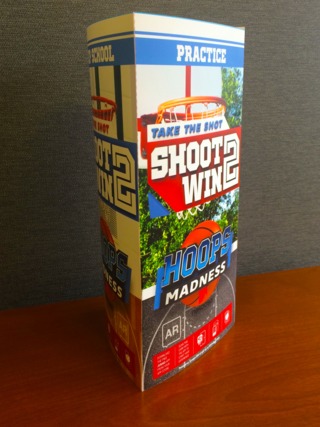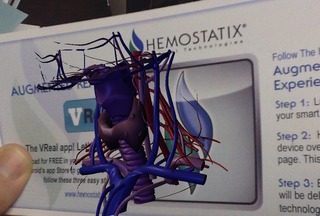Can You Make Money in Augmented Reality?
Has augmented reality (AR) become sufficiently plug-and-play? Can AR be a central part of the print-to-mobile discussion?

For a long time, “print to mobile” meant QR Codes. But is that changing? Has augmented reality (AR) become sufficiently plug-and-play, and have printers’ employee bases become sufficiently digital savvy, to make AR a central part of the print-to-mobile discussion?
The answer to both is yes. As printers and marketing services providers (MPSs) look to expand the value of print and drive more volume through their presses, the opportunities offered by augmented reality need to part of the discussion. Like any new technology, however, this doesn’t mean that it’s going to be seamless and instantly profitable.
If you are going to make money with AR, let’s look at some of the key discussions that need to be taking place.
What’s the Low-Hanging Fruit?
Most of us are familiar with the marketing side of augmented reality. AR offers engagement with customers and shoppers right where they are. Readers can scan a tag on a theater program to view interviews with the actors, see clips from previous shows, and purchase tickets to an upcoming show. They can use AR to watch a product demonstration on product packaging, watch cooking videos directly from their cookbooks, and make better decisions about purchases after watching customer testimonials on product labeling.
Among the available technologies are Layar (now part of Blippar), Aurasma (purchased by HP), and Stampatech InterActivePrint. Metaio, one of the most popular platforms, was purchased by Apple. Aurasma is now offering the opportunity for printers to white label the product, giving them yet another avenue for revenue generation.
Cindy Walas of Walas Younger Ltd. (Chicago) has been working with Stampatech and its project director, Tony Calo, to enhance pieces for her clients. One of the projects is a book designed to teach kids about opera. Using AR, the student can listen to clips, download and print sheet music, and watch videos of performances. “It’s a great way to add content,” she said. “When you publish a book, you only have the budget for a certain number of pages, and there is always more content that you want to get in there. Using AR, you can do that without additional print cost.”
Stampatech can also white label for clients, as well as customize app features for specific client needs.
AR can add value to direct mail, magazines, marketing collateral, and other printed documents. This concept can also be extrapolated to complementary applications. One of the clients of Trekk (Chicago), for example, is a regional mortgage company. For this company, Trekk is creating a series of 50 promotional videos that talk about different aspects of the loan process. “That content will reside on their website and on YouTube, but also on POS in the branch locations,” said MJ Anderson, chief marketing officer at Trekk. “This way, customers in the lobby will be able to scan a poster and watch a video while they are standing in line.”
While most applications of AR are static, using proprietary solutions, AR can be personalized, as well. This adds a layer of complexity that can take some fine-tuning to work out.
EarthColor (Moonachie, NJ) recently printed a project for a large brand that used AR to enhance its customer experience. The client added AR to cards that were given to customers once they signed up for a vacation. When customers placed their phones or tablets over the items, now a character pops up and talks about all of the amazing things the family is about to experience and what they will do on their visit. Each experience is personalized to that individual family.
“In this case, the client did have some kinks to work out because they wanted each AR experience to be personalized,” said Cheryl Kahanec, EVP-Digital of EarthColor. “Adding personalized content required a lot of fine-tuning. They kept asking if this was a printing problem and we said no, this was a coding issue. It required a lot of education.”
Identify the Broader Applications
Marketing applications are the side of AR that we are used to seeing, but it’s only a very small portion of how AR is being used. AR is a massive umbrella technology that is being used for a wide variety of commercial applications ranging from training simulations to document authentication. While many of these “buckets” are not applicable to printers, many of them are.
For example, AR is known for creating very real experiences for consumers with wearables like goggles or headsets that can be used for gaming or virtual search. However, this technology is being used for training, too, and that’s something printers can tap into. Trekk, for example, is currently working with a large national brand to use AR in this way.
“They are looking to use a combination of mixed reality to solve a very real training problem they have in their amusement parks,” said Anderson. “Many of their parks have seasonal employees, and these employees are being training in January or February. It’s not physically possible to be in the park and see it as it will appear in the summertime when they will be working. Using AR, they can give the student the experience of walking through the park while sitting in a classroom. It’s an immersive experience designed to ‘preflight’ them before they get into their jobs.”
In another example, Trekk has several customers using AR to provide exploded diagrams of complicated part assemblies on product sell sheets. “Later, we’ll make the part itself scannable, so if there is a problem on the floor, the technician can scan the part and watch the diagram of the part explode in front of him,” Anderson explains.
Recently, Trekk also created a piece of collateral for a large healthcare provider that will be handed out to cardiac patients. “It’s a 3D model of a beating heart in it, and the physician uses it in a consultation with the patient about heart maladies,” Anderson explains. “It’s a visual aid that a doctor can use to talk to someone about their health.”
Less Sexy, but Still Commercial
There are much less sexy, but still highly commercial applications like logistics, document authentication, and document decryption.
In one pilot logistics project, DHL Supply Chain used “smart glasses” to show task information during the picking process. This includes aisle, product location and quantity. Overall, 10 order pickers used the equipment and picked more than 20,000 items, fulfilling 9,000 orders within the given time frame. As a result, staff was able to operate much faster and error free. DHL and Ricoh are now deciding whether to do a full rollout of the solution.
The authentication side involves capturing a AR tag on an encrypted document, transmitting the tag to an application server, and requesting a decryption key that is used to decrypt a portion of the document. It’s not sexy, but it’s practical and offers great value to many companies.
Some of these applications will be realistic for printers and MSPs to pursue. Others won’t. For example, will you be creating wearable headsets to help shoppers scan their environments to identify shopping and entertainment opportunities? Most likely not. But will you be adding training and entertainment videos to product packaging and direct mail? Why not? How about layers of AR to decrypt documents? In the financial services industry, this is entirely possible.
If you haven’t investigated AR, it’s time to start. More and more clients understand the value of AR, and once they see it in action, they recognize that value almost immediately. (Getting to make the investment is another thing.)
One large entertainment corporation recently asked if Marketing Impact/PrintComm (Detroit, MI) had any experience with AR because it wanted to add interactivity to a direct mail piece. Using Layar, PrintComm worked an AR image into a presentation, and in the words of Kevin Naughton, president of Marketing Impact/PrintComm, the client “flipped.” “They loved it,” he said. “They wanted to know how to build it into their own app.”
PrintComm and the client are still in discussions. In the meantime, PrintComm’s creative team has added augmented reality to one of its client newsletters that will be hitting mailboxes in the next few days. “This has the potential to turn a print piece into a landing page,” Naughton said. “I love that using AR you can do more than just go to a video. You can jump to ecommerce. You can go to a contact form, a phone dialer, or a page with a bunch of push pins that jump you to second level contact.”
Although QR Codes can do these things, too, Naughton said that many clients are resistant to QR Codes because they think they interfere with the design. “By using Layar, there is an app,” he explained. “That makes it easy. People are app-focused. I remember messing with these things three or four years ago, and they were clunky. Not anymore.”
Time to Get Started
There may be little to no software investment, but there is an investment in brainpower to understand and develop the applications. Template-based solutions make low-hanging fruit easy, but to get into the more complex, sophisticated projects, it will take someone who understands the process.
“Printers are willing to go out and make a million dollar investment in a piece of equipment, but they balk at a $50,000 in investment in personnel and time,” noted Trekk’s Anderson. “If they want to benefit from the opportunities of AR, they need to understand the value of service that is not tied to output on a device.”
Because AR can be used as easily in digital marketing as it can in print, it also continues to raise (again) the need to emphasize the value of print as a delivery vehicle. This is why companies like Stampatech make AR part of the prepress process so that the client cannot simply bring the creative process in-house and cut out the middleman.
Augmented reality can be as simple or as complex as you make it. You can use a template-based solution to create simple video applications to add to direct mail and packaging with little investment. It’s straightforward, clients “get” it, and it’s something you can get into right away. At the same time, there is no stickiness to those applications. If clients love the results, they can bring in the creative in-house and take their printing anywhere. For the MSP, the greatest value comes in the more sophisticated projects that take more investment.
It’s time to investigate the options.


